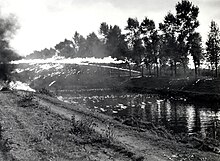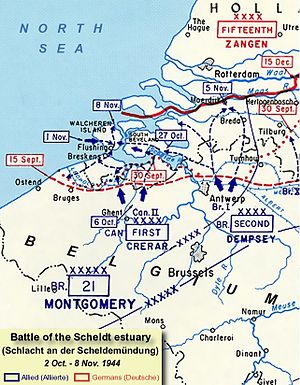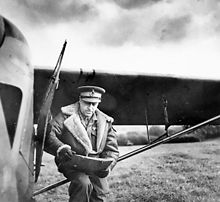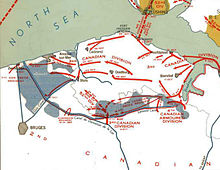Battle of the Scheldt estuary
| date | October 2 to November 8, 1944 |
|---|---|
| place |
Walcheren , Zeeland , Netherlands Antwerp , Flanders , Belgium |
| output | Allied victory |
| Parties to the conflict | |
|---|---|
|
|
|
| Commander | |
| Troop strength | |
|
1st Canadian Army 450,000 men |
15th Army 230,000 men |
| losses | |
|
20,873 dead, wounded and missing, including 6,367 Canadians |
probably 10–15,000 dead and |
1944: Overlord · Dragoon · Mons · Market Garden · Scheldt estuary · Aachen · Hürtgenwald · Queen · Alsace-Lorraine · Ardennes
1945: Nordwind · Bodenplatte · Blackcock · Colmar · Veritable · Grenade · Blockbuster · Lumberjack · Undertone · Plunder · Würzburg · Ruhrkessel · Nuremberg
The Battle of the Scheldt Estuary ( French Bataille de l'Escaut , English Battle of the Scheldt ) was a military operation by the Canadian forces during the Second World War . It took place in the north-west of Belgium and the south-west of the Netherlands between October 2 and November 8, 1944.
prehistory
Wehrmacht troops captured Belgium, the Netherlands and Luxembourg in a kind of blitzkrieg in May 1940 ( “Fall Gelb” ) and in June northern France (“Fall Rot”). On June 22, 1940, France signed a surrender-like armistice . Germany had the Atlantic Wall built from September 1942 to mid-1944 . In the relatively small area of Walcheren alone, around 300 bunker structures with a wall or ceiling thickness of 2 meters or more were built; also hundreds of less protected structures.
After the rapid advance of the Western Allies through northern France and the fleeing retreat of the German troops to Belgium, the Netherlands and West Germany, the British were able to take Brussels with the 2nd Army under General Miles Dempsey in the first days of September . On the further advance along the North Sea coast, Canadians came across abandoned V1 - launchers , which for the use of missiles against London and southern England were used.
A number of Belgian villages had been evacuated by the Germans, in others there were short and fierce fighting . Most of West Belgium could be captured quickly. The Germans withdrew to pre-determined key positions. When the Canadians crossed the Ghent Canal , there was a bitter battle for the bridgehead ; it could only be held with great effort. The Allied troops also met fierce resistance as they advanced east around Antwerp in its northern regions. The supply problems slowly became critical, as the Allies, due to their very rapid eastern advance, had overstretched the supply routes and only ports in Normandy were available. Even the Red Ball Express , which mainly brought fuel and ammunition to the front, couldn't do too much about that. It was therefore imperative to take a large port on the Channel coast . The smaller port cities, which had since fallen into the hands of the Allies, turned out to be too small or too badly damaged after the fighting to be able to serve as delivery points for the supply units of the Navy .
Antwerp was a relatively undamaged large seaport and was occupied by the British 2nd Army at the beginning of September . The 4th Brigade of the Canadian 2nd Infantry Division was responsible for cleaning up and securing the port. Since Antwerp is located in the hinterland of the Scheldt estuary , about 80 kilometers from the coast, it was only possible to use it if it was possible to eliminate the strong German artillery positions on the offshore Walcheren peninsula .
On September 6, the entire Walcheren peninsula was proclaimed the " Walcheren Fortress " (see also Fester Platz ). There was the "free coast of Walcheren" (a northern area from Veere to the north of Westkapelle and a western area from Westkapelle to Groot Valkenisse ) and the "VB Vlissingen" (VB = defense area). The latter had three areas:
- The land front (area from Groot Valkenisse to Fort Rammekens near Ritthem); it is partially protected by a water-bearing anti- tank ditch.
- The sea front (from Groot Valkenisse via Dishoek to Vlissingen). The port area of Vlissingen was particularly protected and was called the "core plant". There were three 150 mm cannons there.
There were three anti - aircraft batteries in the vicinity of Vlissingen.
On September 12th, the 1st Canadian Army received the order to conquer the Scheldt estuary. The first attacks against the German positions there the next day had little success.
Meanwhile, the British 2nd Army had advanced further east into the southern Netherlands. Operation Market Garden was started on September 17, but ended in failure because the Rhine bridge in Arnhem could not be held. The hope that the war would end quickly was a long way off.
The battle
The actual battle of the Scheldt estuary began on October 2nd. Under the command of General Henry Duncan Graham Crerar, the 1st Canadian Army, consisting of the Canadian 2nd and 3rd Infantry Divisions, the Canadian 4th Armored Division, the British 1st Corps and the Polish 1st Armored Division , advanced against the Germans . Americans, Dutch and Belgians also fought in smaller units. In total, the army had around 450,000 soldiers.
The battle took place on flooded, muddy terrain, and the well-positioned and strong defenses of the Germans made them grueling and costly to the attackers. Many historians see it as the battle of World War II, which took place on the most difficult terrain of all. General Crerar had meanwhile been flown to Great Britain because of a serious illness and Lieutenant-General Guy Simonds had taken command.
The particularities of the battlefield made the task of the 1st Canadian Army very difficult. North of the Scheldt estuary is North Beveland , below it South Beveland with the island of Walcheren behind it , which was heavily fortified by the Germans. On the south bank of the estuary there is flat flood terrain, the so-called polderland , below sea level and easy to defend.
The plan to secure the estuary was divided into four phases:
- Capturing the area north of Antwerp and securing access to North Beveland,
- Dissolution of the boiler near Breskens behind the Leopold Canal ( Operation Switchback ),
- Taking South Beveland (Operation Vitality) and
- Taking Walcheren (Operation Infatuate).
In early October the Canadian 2nd Infantry Division advanced north of Antwerp. At the same time, the Canadian 3rd Infantry Division, with the support of the Canadian 4th Armored Division, began the advance across the Leopold Canal. Fierce fighting developed on both sectors of the front because the well-fortified German positions made it difficult for the Allies to achieve quick successes.
In the north of Antwerp, the Canadians encountered German paratroopers defending the eastern end of South Beveland. With heavy losses it was possible to penetrate through the flooded areas to Woensdrecht by October 16 . On the same day, Field Marshal Bernard Montgomery, as commander of the 1st Canadian and British 2nd Armies, made clearing the Scheldt estuary a top priority.
Operation switchback

Fierce fighting also took place on the south side of the Scheldt. The Germans had heavily fortified artillery positions behind the Leopold Canal and the Dérivation de la Lys . As a crossing point, the Canadians chose the branch triangle of both channels. There was a narrow area of dry land there, a few hundred yards wide. While the Canadian 3rd Infantry Division tried to cross the Leopold Canal on October 6, it came under heavy German defensive fire. She responded with heavy artillery fire and universal carriers with flamethrowers , the so-called wasps . Two small bridgeheads could be erected, but when the Germans recovered from the initial surprise, they responded with a violent counterattack. Until October 9, it was uncertain whether the bridgeheads could even be held. After another amphibious canal crossing with stronger troops, the Canadians managed to unite the two and significantly widen the bridgehead to advance towards Breskens . When tanks crossed the canal, the defenders withdrew to their concrete bunkers along the coast. The Canadians established a supply route into the cauldron and began to besiege the cities of Breskens, Fort Frederik Hendrik , Oostburg , Zuidzande and Cadzand . It was not until November 3rd that Knokke and Zeebrugge were taken; from then on the Canadians considered the south side of the Scheldt to be secure.
Operation Vitality
Simonds meanwhile concentrated his troops in the area north of South Beveland. The Canadian 4th Panzer Division was now advancing north of the Scheldt to the west and attacked Bergen op Zoom . By October 24th, the entrance to South Beveland was secured. The Canadian 2nd Infantry Division advanced on South Beveland shortly thereafter. However, the rapid capture of the island was prevented by the heavily mined road. At the same time, Operation Infatuate made an amphibious landing by the British 52nd Division a. a. across the Westerschelde to get behind the German defense positions.
Operation Infatuate
Walcheren thus remained the last obstacle that separated the port of Antwerp from being used by the Allies. In order to attack the strong German fortifications there, the Canadians had to advance along the long, narrow access road over South Beveland. The flat land on either side of the road was flooded; no foot troops could advance there. The water was too shallow for assault boats .
Walcheren was attacked from three directions: via the access road from the east, via the Scheldt from the south and from the sea from the west. To weaken the defenses and aid the attack, the Royal Air Force bombed the island's dams so that the hinterland could be flooded and amphibious vehicles could be used.
The advance on the access road began on October 31. After heavy fighting the Canadians managed to secure their first position on Walcheren. Together with the troops coming from the Scheldt and the seaside under Major General Edmund Hakewill-Smith , further progress could then be achieved. A counter-attack on the night of November 1, in the Westerschelde by German speedboats led to the sinking of a Canadian ammunition transporter, a barge with anti-aircraft gun and a spotlight Frahm . A day later, further German companies by speedboat flotillas at Ostend resulted in the loss of a tanker and a trawler .
On November 6th, Canadian units captured Middelburg . Two days later, the German resistance finally ended. In mid-November, British destroyers escorted German attack attempts from the seaside.
Meanwhile the Canadian 4th Panzer Division had advanced from Bergen op Zoom to the northwest to Sint-Philipsland . In the port of Zijpe to the west , they succeeded in sinking a number of German speedboats.
Result
After the Scheldt estuary and the area from Antwerp to the Meuse had been cleared , the actual battle was over. However, before a ship could sail the Scheldt as far as Antwerp, the river had to be laboriously cleared of the sea mines laid there . The V2 shots from the Eifel region , the Cologne / Bonn area and the Netherlands on Antwerp , ordered by Hitler on October 12, impaired public life in the city and the development of logistics in the port area. On November 28, the first convoy led by the Canadian freighter Fort Cataraqui entered the port.
With the replenishment deliveries that could now be transported to the front via the Antwerp port, the Allies had solved the greatest problem. But since they had extended the front line to the north through Operation Market Garden a few weeks earlier and strong American forces were tied up there during the All Souls' Battle in the Huertgen Forest, there were opportunities for the Germans to attack in the Ardennes area . On December 16, 1944, the Wehrmacht launched the Ardennes offensive . The destination was the port of Antwerp to stop the Allied supplies.
Memorials
The Canadian and other Allied victims of the battle are buried in two Commonwealth cemeteries. In the north-west of Belgium, not far from the Dutch border, there is a cemetery near Adegem , between Brugge and Ghent , where 1119 soldiers (848 Canadians, 33 Poles and 2 French) are buried. Most of them died in the Breskens pocket.
Another cemetery is located in the southwest of the Netherlands, 40 kilometers northwest of Antwerp near Bergen op Zoom (1116 graves, 968 of them Canadians). A few hundred meters away is another cemetery, where 1200 British, 45 Canadian, 12 Australian and 23 New Zealand soldiers are buried.
Other graves of soldiers involved in the fighting can be found in the Schoonselhof cemetery in Antwerp (348), the Heverlee war cemetery near Leuven (157), the Hotton war cemetery (88) and the main cemetery in Brussels (74).
On the war graves cemetery Ysselsteyn (Limburg) all lie in the Second World War in the Netherlands fallen or dead Germans, if they are not transferred to the home.
literature
- Andrew Rawson: Walcheren: Crossing the Scheldt . Pen and Sword Books, 2003, ISBN 0-85052-961-1 .
- W. Denis Whitaker, Shelagh Whitaker: Battle of the Scheldt . Souvenir Press, 1985, ISBN 0-285-62696-5 .
- W.Denis Whitaker, Shelagh Whitaker: Tug of War: Eisenhower's Lost Opportunity: Allied Command & the Story Behind the Battle of the Scheldt . Beaufort Books, 1985, ISBN 0-8253-0257-9 .
- Official History of the Canadian Army in the Second World War, Vol. III (1966)
Web links
- The Liberation of Belgium. Canada Remembers (English)
- The Scheldt. Canada Remembers (English)
- The Battle of the Scheldt. (English) including videos
- Liberation of Belgium (English)
- Missiles on Antwerp . Time online
Individual evidence
- ↑ a b The Atlantic Wall in Walcheren on discover-walcheren.de
- ↑ infovlissingen.nl (with further links)
- ↑ Bunker 700
- ↑ core plant Vlissingen infovlissingen.nl







